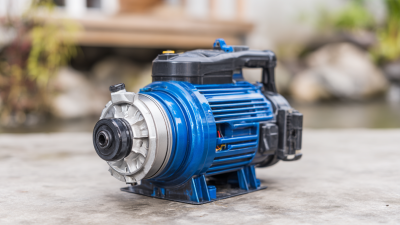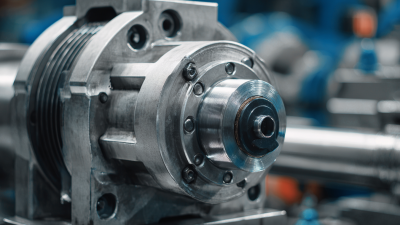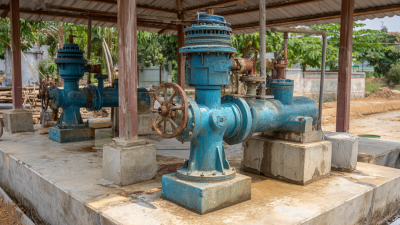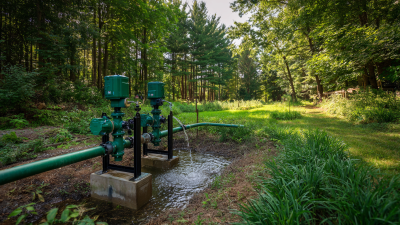Our Blog
Check out our innovative pump solutions and industry insights to see what's new in the pumping industry. Stay up to date with the latest trends and news in the world of pumping technology by following our pumping technology blog.
- Home
- Blog
Maximizing Efficiency: How Submersible Pumps Revolutionize Water Management in Agriculture
Efficient water management is a critical component of modern agriculture, where the demand for sustainable practices continues to rise. Submersible pumps have emerged as a transformative technology in this sector, enhancing irrigation capabilities and optimizing resource use. According to a report by the Food and Agriculture Organization (FAO), agricultural water use accounts for about 70% of global freshwater withdrawals, highlighting the need for efficient systems to manage this invaluable resource. The integration of submersible pumps in farming practices offers significant benefits, including improved water delivery efficiency and reduced energy consumption.

These pumps operate underwater, allowing them to provide a continuous supply of water directly to crops while minimizing evaporation losses and energy expenditure. A study by the International Water Management Institute suggests that the adoption of advanced irrigation technologies, including submersible pumps, can potentially increase water-use efficiency by up to 50%. This efficiency not only conserves water but also leads to enhanced crop yields, thereby supporting food security in an era of climate change and population growth. As the agricultural sector continues to innovate, submersible pumps stand out as a key player in promoting sustainable water management practices, offering a practical solution to the challenges faced by farmers worldwide.
Advantages of Submersible Pumps in Agricultural Water Management
Submersible pumps are transforming agricultural water management by providing numerous advantages that enhance operational efficiency. One of the primary benefits is their ability to function underwater, which minimizes energy loss and allows for more effective water extraction. By being submerged in the water source, these pumps can operate quietly and continuously, ensuring a stable supply of water for irrigation systems. This greatly reduces the risk of pump overheating and mechanical failures, making them a reliable choice for farmers.
Another significant advantage is their versatility in various agricultural settings. Submersible pumps can be used in wells, boreholes, and even reservoirs, adapting to a range of water levels and quality. Their design allows for deeper water extraction, which is particularly beneficial in regions facing water scarcity. Additionally, these pumps often feature advanced technology, such as variable speed drives, enabling farmers to customize water delivery according to specific crop needs and environmental conditions. This precision not only optimizes water use but also promotes sustainable farming practices by conserving valuable resources.
Maximizing Efficiency: How Submersible Pumps Revolutionize Water Management in Agriculture
| Aspect | Submersible Pump Advantages | Impact on Agricultural Water Management |
|---|---|---|
| Energy Efficiency | Lower energy consumption compared to surface pumps | Reduced operational costs for farmers |
| Space Saving | Designed to be installed underwater, saving above-ground space | More land available for crops |
| Durability | Built to withstand harsh conditions | Lower maintenance and replacement costs |
| Versatility | Suitable for various water sources | Flexibility in different farming operations |
| Automation Capability | Can be integrated into smart irrigation systems | Enhanced water management efficiency |
Key Considerations for Selecting the Right Submersible Pump
When selecting the right submersible pump for agricultural water management, there are several key considerations to keep in mind. The efficiency and reliability of a pump can significantly impact crop yields and overall farm productivity. It's essential to assess the pump's capacity, power requirements, and the type of fluid it will handle. Understanding the specific needs of your agricultural operations will help narrow down the options and ensure effective water management.
Tips: One important tip is to evaluate the depth of the water source. Pumps are rated for certain depths, and selecting one that matches the depth you need will optimize performance. Additionally, consider the pump's energy efficiency, as this can lead to cost savings over time, especially given the growing market for household water pumps projected to increase from $18.58 billion in 2024 to $26.92 billion by 2032.
Furthermore, the material and design of the submersible pump should be taken into account. Pumps made from corrosion-resistant materials are ideal for agricultural applications as they can handle various water qualities without degradation. Always consult with professionals or trusted suppliers to ensure that you're making an informed decision tailored to your specific water management challenges.
Innovative Technologies Enhancing Pump Efficiency and Durability
Innovative technologies are at the forefront of enhancing the efficiency and durability of submersible pumps used in agricultural water management. By incorporating advanced materials and designs, these pumps can withstand harsh conditions while maintaining optimal performance. For instance, manufacturers are now utilizing corrosion-resistant alloys and high-grade plastics, which extend the lifespan of the pumps and reduce maintenance costs. These materials not only improve durability but also allow for better energy efficiency, ensuring that farmers can operate pumps with minimal environmental impact.
Additionally, the integration of smart technologies into submersible pumps has significantly transformed their operational capabilities. Many modern pumps are equipped with IoT sensors that monitor various parameters, such as flow rates, temperature, and pressure in real-time. This data allows farmers to optimize their irrigation schedules, ensuring water is used as efficiently as possible. Furthermore, remote control features enable operators to make adjustments from a distance, providing convenience and responsiveness to changing weather conditions. With these innovations, submersible pumps are revolutionizing the landscape of agricultural water management, making operations not only more efficient but also more sustainable.
Best Practices for Maintenance and Troubleshooting of Submersible Pumps
Submersible pumps have become essential tools in agricultural water management, providing efficient solutions for irrigation and drainage. However, to maximize their performance and longevity, proper maintenance and troubleshooting are crucial. Regular inspections can help identify potential issues before they escalate. Make sure to check the electrical connections, seals, and floats regularly to ensure they are free from wear and tear.
One of the best practices for maintaining submersible pumps is to establish a routine cleaning schedule. Sediment build-up can lead to pump inefficiency and failure. Tips for effective cleaning include using a soft brush to remove debris from the pump's exterior and ensuring that intake screens are free of clogs. If you notice any unusual noises or vibrations during operation, these could be early signs of problems. Addressing them promptly can save you time and money in the long run.
Another key aspect of maintenance is monitoring the pump's performance metrics, such as flow rate and energy consumption. Keeping track of these can help you detect any drop in efficiency, allowing for timely interventions. Regular maintenance not only extends the life of your submersible pump but also contributes to sustainable agricultural practices by ensuring a steady water supply for your crops.
Maximizing Efficiency: Submersible Pumps in Agriculture
This chart illustrates key performance metrics for submersible pumps used in agricultural water management. It highlights the average water flow rate, energy efficiency, annual maintenance cost, and overall uptime percentage, emphasizing the importance of these factors in maximizing efficiency.
Future Trends in Submersible Pump Design for Sustainable Agriculture
The future of agriculture is rapidly evolving, particularly through the advancement of submersible pump technology which plays a critical role in water management. As the global demand for sustainable agricultural practices increases, submersible pumps are being redesigned to improve efficiency and reduce operational costs. According to a recent industry trend report, the global home water pump market is projected to grow significantly, with an estimated value of $18.58 billion in 2024, expected to reach $26.92 billion by 2032, reflecting a compound annual growth rate (CAGR) of 4.8%. This growth underscores the increasing reliance on efficient water management tools in agricultural settings.
Future trends in submersible pump design emphasize enhanced energy efficiency and environmentally friendly materials. Innovations in variable speed technology allow these pumps to automatically adjust their output based on system demand, leading to substantial energy savings. Moreover, manufacturers are increasingly focusing on the integration of smart technologies, such as IoT capabilities, to enable real-time monitoring and predictive maintenance. This shift not only optimizes water usage but also reduces waste, aligning with the sustainable agriculture goals shared by many countries globally. As design and functionality continue to improve, submersible pumps will become integral to achieving higher agricultural productivity while conserving vital water resources.
Related Posts
-

Unlocking Efficiency: The Ultimate Guide to Choosing the Right Motor Pump for Your Needs
-

Exploring the Efficiency of Submersible Water Pumps: A Comprehensive Guide for Homeowners
-

Exploring the Benefits and Applications of 2 Submersible Pumps in Modern Water Management
-

Understanding the Innovations of Pump Manufacturers in Modern Industrial Applications
-

The Ultimate Guide to Choosing the Right Deep Well Water Pump for Your Needs
-

Top 5 Benefits of Upgrading Your Well Pumps for Improved Water Quality and Efficiency

